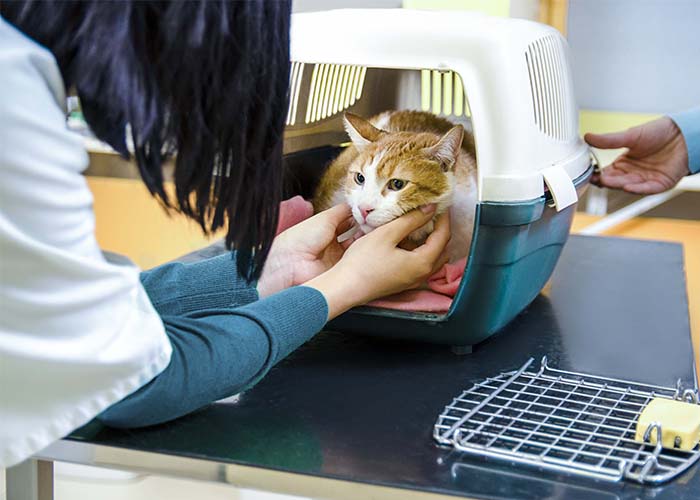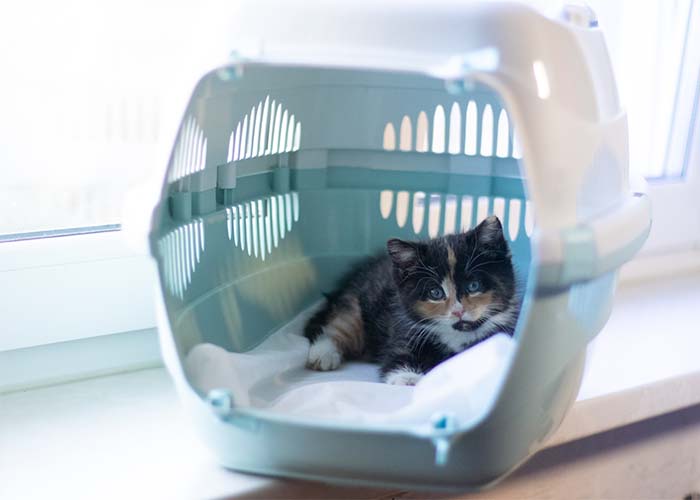
If you love cats, you know that they are curious, independent, and a joy to have around. They are also easily scared, like to be in control, and are homebodies. They are often suspicious of new places and people and do not like loud noises or unfamiliar smells. All of this can make vet visits challenging for cats and the humans who love them.
Cats have been known to hiss and swat, try to bite, or even try to escape while at the veterinarian. When these behaviors occur, there is no need to feel guilty or embarrassed! Remember that there are no bad cats. When you remove your cat from your home, they are stressed which causes a variety of reactions. Your vet should expect these reactions and be ready to handle the situation.
The good news is that there are many ways to lessen the stress that cats (and their owners) are experiencing. While you may never make a trip to the vet 100% stress free, there are things you can do to make it as low stress as possible.
Choosing a Carrier
Cats tend to like to hide. They like a quiet and secure space that smells familiar. So, while many cats have learned to enjoy walking on a leash and exploring around their house, the best place for our cats when they are at the hospital is in a carrier. You can set up the carrier so that it is a quiet space that smells like home. This is the first step to a good experience for our cat patients.
If you have an outgoing, adventurous cat, then any carrier will do. But if your feline friend gets nervous, a hard-sided, plastic carrier is a good choice. This makes them easy to clean and cats can lay quietly inside without it collapsing around them. It’s also helpful to have a top loading option on the carrier. You have probably seen your cat jump promptly into an open box in your home. While they may not jump right into the carrier, it is easiest to gently place a cat into the carrier from the top.
Using the Carrier
While cats are interested in exploring new objects that come into their homes, they are not interested in being “forced” into or around those objects. So, making the carrier a familiar part of their daily life is helpful. Leaving the carrier out in a main room, with a favorite blanket or cat bed in it, is the best way to ensure your cat enjoys their carrier. Leave the door and top open and occasionally leave treats and toys in the carrier. Once your cat is comfortable going into the carrier on his/her own, then you can practice placing them in the carrier.
The best way to get your cat into the carrier is to pick him/her up securely under the chest and then scoop the hind end into your other hand. Hold your cat close to your body as this keeps them feeling secure. If your cat gets wiggly or tries to escape, using a bath towel to scoop them up will help you control the legs and reduce escape attempts. When you approach the carrier, gently tip your cat headfirst through the top opening. Once inside the carrier, you can quietly close the top. Make a game of this. Place your cat in the carrier, give him a treat and then let him jump out. Again – cats are inherently mistrustful of new experiences. So, get them use to the carrier before you take them to the vet.
Covering the carrier with a blanket when you are driving and when you are at the clinic is also helpful. The blanket will deaden unfamiliar noises and smell like home. Using a pheromone spray – like Feliway – on the blanket before leaving home can also help.

At the Clinic
At the clinic, be sure the carrier doors are well secured before you remove the carrier from the car. Once inside, the goal is to keep your cat in a quiet place until they are ready to be seen. Many clinics have a cats-only waiting room. Another option is to wait in the car until it is time to be seen. Once in the exam room, it is best to keep your cat in the carrier and the carrier covered. You may also want to place the carrier on the exam table because cats often feel safer on an elevated surface.
When it’s time to examine your cat, the veterinary team can determine the best way to move forward. Some cats will willingly exit the carrier and be interested in interacting with the team and exploring the room. Your veterinarian should open the carrier and give them a little time to get used to the new environment.
However, many cats would rather stay in their carrier. This is where the type of carrier becomes important. If you can remove the top of the carrier and cover the cat with a towel, your cat may feel safe and secure in the bottom of the carrier. Your veterinarian may be able to do a complete exam this way.
If your cat is still too stressed, sedation can be safely given to a cat hiding under a towel when the top is off the carrier. Sedation is a safe way to allow for a thorough exam and any testing that may be needed. It is just another tool for a low-stress veterinary visit.
Anti-Anxiety Medication
What if you have tried all this? You have a good carrier that your cat is used to, you have practiced putting your cat into the carrier. You ask for a quiet place for your cat to wait, and your veterinarian works slowly and calmly with your cat. What if they are still stressed? Your veterinarian may offer an oral sedative called Gabapentin or other anti-anxiety medication.
Your Veterinarian is Your Partner
It is our job as veterinary professionals to handle your cat in a way that is the least stressful for them. Sometimes this means taking the time for your cat to get comfortable in the room, other times this means taking the top off the carrier and examining your cat securely wrapped in a towel, and there can be times when using safe sedation is the best route.
Making use of some of these suggestions will hopefully make your cat more comfortable and ready to handle the stress of a visit to the veterinarian. Knowing that the reactions of your cat to their veterinarian are NORMAL cat behavior will hopefully make you less stressed as well. Medical care is important to the long-term health and wellbeing of your cat. So, taking the time to get them comfortably and safely to their veterinary appointment is well worth the effort.